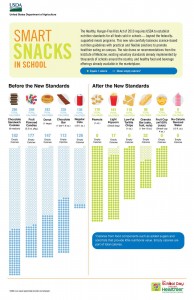See you later sugary soda, chips, and candy! You see, you are once-in-a-while foods which have no place in schools where students can buy you every day. It is time to feed our kids the fuel they need to get through the school day, to support their physical health, and to teach them how to live healthy lives. And that is exactly what the U.S. Department of Agriculture (USDA) is trying to do with a big announcement this week finalizing the new rules about what snack foods and beverages are allowed to be sold to our kids in school. It was a nice surprise that the department moved so quickly to read through all of the public comments (many submitted by MomsRising bloggers and readers!) and issued the interim final guidelines.
So, what does this mean? This means that kids all over the country no longer need to choose between the apple and the honey bun; they can choose between the apple and the orange. This means that when my youngest son starts kindergarten in 2014, the year schools must be in compliance, healthy foods at school will be the new normal. And this means that the voices of parents, educators, and healthcare professionals have been heard—junk food does not belong in our nation’s schools.
Is the new rule perfect? No, but it is a huge step forward for the USDA which has never had the authority to set standards on the foods and beverages sold outside of the federal school meals program (updated nutritional standards for those meals went into effect last fall). The nutrition criteria for foods sold in vending machines, a la carte lines, and school stores have not been touched in more than 30 years. And we all know what happened during that time period; childhood obesity rates skyrocketed to epidemic proportions.
Many of these shifts towards healthier foods in schools have already been realized on campuses across the country, such as those schools participating in the Alliance for a Healthier Generation. These schools have been voluntarily implementing similar guidelines for meals and snacks for the last seven years. This is good news for all schools because it means that the Alliance has experience, staff, and resources to help guide schools through this process, at no cost.
Although schools have one year to fully implement these changes, it is definitely a good idea to get a head start. School and district staff will need to start looking at what products they have, what they need to change, gather student feedback, and work with vendors. Don’t get me wrong, I’m not glossing over the fact that these will be difficult changes for some schools. But this is the right thing to do and the right time to do it.


The views and opinions expressed in this post are those of the author(s) and do not necessarily reflect those of MomsRising.org.
MomsRising.org strongly encourages our readers to post comments in response to blog posts. We value diversity of opinions and perspectives. Our goals for this space are to be educational, thought-provoking, and respectful. So we actively moderate comments and we reserve the right to edit or remove comments that undermine these goals. Thanks!